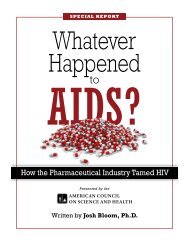The Role of Beef in the American Diet - International Meat Secretariat
The Role of Beef in the American Diet - International Meat Secretariat
The Role of Beef in the American Diet - International Meat Secretariat
You also want an ePaper? Increase the reach of your titles
YUMPU automatically turns print PDFs into web optimized ePapers that Google loves.
<strong>The</strong> <strong>Role</strong> <strong>of</strong> <strong>Beef</strong> <strong>in</strong> <strong>the</strong> <strong>American</strong> <strong>Diet</strong><br />
temperature <strong>of</strong> <strong>the</strong> freezer is ma<strong>in</strong>ta<strong>in</strong>ed at 0°F or lower. Food that is<br />
stored constantly at 0°F or lower will stay safe <strong>in</strong>def<strong>in</strong>itely, but its quality<br />
will deteriorate over time. <strong>The</strong> recommended maximum frozen storage<br />
times for beef and o<strong>the</strong>r foods are based on quality ra<strong>the</strong>r than safety<br />
concerns. For specific <strong>in</strong>formation on how long you can freeze beef<br />
and o<strong>the</strong>r foods without an unacceptable decrease <strong>in</strong> quality, consult <strong>the</strong><br />
U.S. Department <strong>of</strong> Agriculture’s Web site at http://www.fsis.usda.gov<br />
/ O A / p u b s / f r e e z i n g . h t mand h t t p :// w w w. f s i s . u s d a . g o v / o a / p u b s / f o c u s b e e f . h t m<br />
IX. Irradiation<br />
Food irradiation is <strong>the</strong> controlled treatment <strong>of</strong> foods with ioniz<strong>in</strong>g<br />
radiation, such as gamma rays or X-rays. * This process can be used to<br />
kill disease-caus<strong>in</strong>g bacteria. It can be particularly useful <strong>in</strong> situations<br />
where <strong>the</strong> bacteria may be distributed throughout <strong>the</strong> product, such as<br />
with ground meats. Most o<strong>the</strong>r techniques for kill<strong>in</strong>g bacteria ei<strong>the</strong>r<br />
work only on <strong>the</strong> surface (e.g., steam vacuum<strong>in</strong>g <strong>of</strong> carcasses at a meat<br />
pack<strong>in</strong>g plant) or dramatically change <strong>the</strong> food (e.g., cook<strong>in</strong>g).<br />
Irradiation can kill bacteria <strong>in</strong> <strong>the</strong> <strong>in</strong>side <strong>of</strong> <strong>the</strong> meat without caus<strong>in</strong>g<br />
unacceptable changes <strong>in</strong> flavor or nutritive value and without cook<strong>in</strong>g<br />
<strong>the</strong> food. <strong>Meat</strong> can be irradiated with<strong>in</strong> its packag<strong>in</strong>g, thus protect<strong>in</strong>g it<br />
aga<strong>in</strong>st recontam<strong>in</strong>ation until <strong>the</strong> package is opened by <strong>the</strong> user. In<br />
many ways, irradiation is much like <strong>the</strong> heat pasteurization process used<br />
on milk and fruit juices. Both processes kill disease-caus<strong>in</strong>g bacteria<br />
without caus<strong>in</strong>g major changes <strong>in</strong> <strong>the</strong> food product, and both are particularly<br />
useful <strong>in</strong> situations where good sanitation alone may not be able<br />
to ensure <strong>the</strong> microbiological safety <strong>of</strong> a raw food.<br />
Irradiation is a safe and well-tested process (64–66). It does not<br />
make food radioactive or cause dangerous chemical changes <strong>in</strong> food; <strong>in</strong><br />
fact, <strong>the</strong> chemical changes that result from irradiation are similar to<br />
those produced by more familiar processes such as cook<strong>in</strong>g. <strong>The</strong><br />
process can be conducted without pos<strong>in</strong>g hazards to <strong>the</strong> environment or<br />
to workers. <strong>The</strong> necessary safety precautions are already well understood<br />
because <strong>the</strong> same process has been used for many years to sterilize<br />
medical equipment and consumer products such as contact lens solutions.<br />
Irradiation has been approved for many years for various food<br />
uses, such as kill<strong>in</strong>g <strong>in</strong>sects and bacteria <strong>in</strong> spices and destroy<strong>in</strong>g <strong>the</strong><br />
causative agent <strong>of</strong> trich<strong>in</strong>osis <strong>in</strong> pork. However, it was not until 1997<br />
that <strong>the</strong> Food and Drug Adm<strong>in</strong>istration (FDA) approved irradiation to<br />
* For more <strong>in</strong>formation on food irradiation, see <strong>the</strong> ACSH report Irradiated Foods, available<br />
onl<strong>in</strong>e at http://www. a c s h . o rg / p u b l i c a t i o n s / b o o k l e t s / i r r a d i a t e d . p d f .<br />
31










